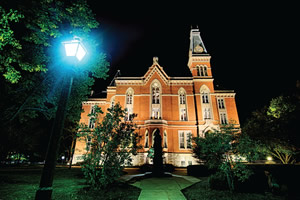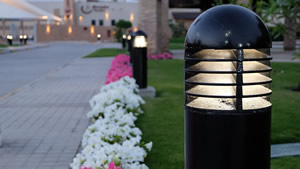Facilities (Campus Spaces)
Lighting the Way on Campus
- By Tom Kaczkowski
- 03/01/18

PHOTO COURTESY OF DEPAUW UNIVERSITY
Eight a.m. classes. Afternoon meetings. Office hours. On-campus meals. Late-night study sessions. Today’s college students and faculty members have demanding schedules that often involve early mornings and late nights, keeping campuses lively at all hours.
“As the lifestyles of students and faculty change because of schedule and performance demands, the design of our campuses must also evolve,” says Julia Heutel, a senior HOK lighting designer who has worked with universities across the U.S. “We are acutely aware that we must do everything possible to make campuses secure, welcoming, and easy to navigate for every individual at any time of day.”
Creative exterior lighting solutions can help university administrators and maintenance staff improve security, streamline wayfinding, and communicate branding in tangible ways.
“Successful lighting design responds to the lives and behaviors of today’s students and faculty,” explains Heutel. “Today’s campuses are 24-hour-a-day facilities. Students, faculty, and visitors should be able to navigate a campus with complete ease, whether it’s 10 a.m. or 10 p.m.”
Enhancing Security and Wayfinding
As they take inventory of their lighting strategies, security is often the primary concern for colleges and universities. Day or night, lighting can contribute to and communicate safety. Lighting pathways, streets, or building entries offers opportunities to facilitate a greater sense of security that enhances the campus experience.
Lighting can also contribute to campus-wide wayfinding directives by identifying beacon buildings, drawing people into spaces, or leading them along a predetermined path.
At DePauw University in Greencastle, IN, administrators used lighting to draw attention to one of the campus’ most significant buildings: East College. Located in the heart of DePauw’s central quad, this historic gathering space opened in 1877.
“The simple exercise of installing LED floodlighting changed the quad, emphasizing the building’s significance to the campus,” says Heutel. “The client saw firsthand the impact lighting can have on creating a focal point that simultaneously achieves their goals for wayfinding and storytelling.”
Emphasizing landmarks like East College can be critical for helping people navigate the campus who visit each year for community gatherings, speaking and sporting events, and conferences. Lighting provides visual cues that draw the eye to important spaces and help visitors orient themselves on a campus that could otherwise be overwhelming in scale.
Lighting as Branding
The impact of lighting isn’t limited to logistical issues of security and wayfinding. Lighting helps promote a university’s brand by establishing a common architectural vocabulary and campus lighting standard.
At Saint Louis University in Missouri, the recognizable “SLU blue” is incorporated in uplighting that defines its boundaries and brand across the urban campus. It’s an example of how school colors can be elegantly incorporated, whether that be in lighting posts, accent rings on bollards, or uplit portions of a luminaire. These elements then work in concert with the streetscape to create an identifiable design standard for lighting and landscaping.
“The cadence of the trees, paving patterns, style of brick, and lighting selections are part of a common design language that provides the foundation for future campus growth,” says Heutel. “When a campus expands, those design standards create familiarity.”
Where to Begin?
Acknowledging the need for improved lighting to address these concerns is one thing. But where to begin for an administrator or campus architect?
First, it’s important to determine the scope of the project. Explore whether you have the budget to reimagine lighting across the campus as part of a master planning exercise, or if you need to identify key projects that can be done incrementally to align with planned campus improvements or new building projects.
A recent project at Rice University in Houston involved the latter. While university administrators had determined the specific luminaire they wanted to use at the time the RFP was distributed, they hired an architectural lighting partner to advise on how and where to incorporate additional security lighting without detracting from the campus’ ubiquitous acorn lights, which are synonymous with the school’s identity.
At DePauw University, the East College project catalyzed a holistic look at the campus’s lighting challenges and plans for future growth. Collaborating with DePauw’s master planners, HOK helped stakeholders define future major access points on campus and determine how lighting could identify them. As these entry points and central gathering spaces change, so will primary pedestrian paths and secondary roadways.
Next, stakeholders should visit other campuses both during the day and night to understand what they like and inform their goals for campus lighting. There is no substitute for personally experiencing certain lighting techniques. HOK even takes our clients to tour corporate campuses and well-planned city districts to help them experience innovative techniques being used outside of college campuses.
Armed with this benchmarking information and a clear project scope, Heutel recommends that universities go through a lighting charrette with their design partner. This conversation will encourage university leaders and stakeholders from the facilities, operations, and maintenance departments to discuss lighting strategies that have or haven’t worked in the past and how they hope to use lighting in the future to create the best campus experience.
Lighting the Campus of the Future
For some universities, the charrette leads to conversations about future technology. While many of these concepts are in their early stage of development, they provide a glimpse into the campus of the future

WALK THIS WAY. Options for exterior lighting on campus include bollards that function as light fixtures at and after dark. While they are commonly used to keep traffic away from people, parks, lawns, and buildings, bollards with lights can become a featured addition to illuminate and accent landscaping, walkways, buildings and parking areas, as well as provide wayfinding and improve security by increasing visibility.
• Tracking Technology. Global positioning technology, to date used mostly in interior environments, allows universities to track people’s movements across a campus. “Imagine a student walking from the library to her dorm at 2 a.m.,” says Heutel. “This tracking technology, which could be embedded in light fixtures, would allow campus security to chart her movements. This same technology could be applied to track campus assets like golf carts or vehicles carrying materials or people. In the future, this notion of using light fixtures for data collection and security could have serious implications on how we approach lighting design, including the positioning of fixtures.”
• Interactivity. Students and staff move between buildings at all hours. Interactive, responsive lighting could go beyond motion sensor-activated lighting and illuminate entire paths as sensors recognize movement. If an individual is looking for a destination on campus, an interactive app could allow him to identify the building on a map and responsive lighting could light up the pathway leading to that building.
• Health and Wellness. Data and lighting controls can positively impact the health and well-being of students. The color of white light, for example, can be manipulated to impact circadian rhythms. In the classroom of the future, a professor will be able to push a button and enhance a student’s ability to learn by changing the color temperature, perhaps by making the classroom brighter to prevent students from nodding off after lunch. It’s even possible that universities would look to lighting professionals and researchers to find out how light could be prescribed to affect the students’ daily biorhythms.
• Revenue Generation. Geofencing, the use of GPS or RFID technology to create virtual geographic boundaries, is a relatively new concept
on campuses. Geofencing requires participants to opt in to push notifications and location-based tracking through a mobile app. If potential customers are driving by a Target store, for example, they could trigger app notifications about relevant sales based on their past buying patterns. Students and staff walking past a campus bookstore or coffee shop could be detected by geolocation markers embedded in light fixtures and relevant discounts or upcoming events could be shared with them. Retailers value this data, which could create a new revenue stream for the university. This same technology could help attract students to academic and social events.
One caveat about equipping light fixtures with tracking technology is that this can produce overwhelming amounts of data that needs to be analyzed to make it useful. But this presents an enormous opportunity for universities to take ownership of the data to benefit the student experience.
“Lighting can transform the campus experience,” says Heutel. “These new technologies and the data that they produce, when coupled with contemporary security, wayfinding, and branding strategies, give us a window into the campus of the future—one with endless opportunities for lighting to positively shape the environments where we learn, live and grow.”
This article originally appeared in the College Planning & Management March 2018 issue of Spaces4Learning.